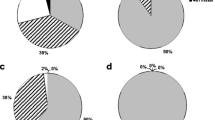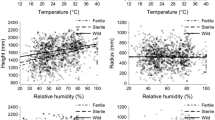Summary
Using caged host trees on which we manipulated food and oviposition sites, we investigated the foraging behavior of individually-releasedBactrocera tryoni (Diptera: Tephritidae) females in relation to state of fly hunger for protein, presence or absence of bacteria as a source of protein, degree of prior experience with host fruit, and quality of host fruit for oviposition. One aim was to evaluate whether it is immature or matureB. tryoni females that are responsible for initially inoculating host fruit surfaces with “fruit-fly-type” bacteria, the odor of which is known to attractB. tryoni females. We found that 3-week-old immature females provided with sucrose but deprived of protein from eclosion had a much greater propensity than 3-week-old protein-fed mature females to visit vials containing fruit-fly-type bacteria, irrespective of whether vials were associated with adjacent host fruit or not. In the absence of associated bacteria in vials, immature females had a much lower propensity than mature females to visit host fruit. In the presence of bacteria in vials, however, propensity of immature and mature females to visit fruit was about equal. Mature (but not immature) females were more inclined to visit fruit that ranked higher for oviposition (nectarines) than fruit that ranked lower (sweet oranges). Mature females that attempted oviposition during a single 3-min exposure period to a nectarine prior to release were much more likely to find a nectarine than were mature females naive to fruit or immature females with or without prior contact with fruit. Exposure to a nectarine before release did not affect the propensity of either mature or immature females to alight on an odorless visual model of a nectarine, however. As judged by numbers of leaves visited, protein-deprived immature females were more active than protein-fed mature females, irrespective of the sorts of resources on a tree. Together, our findings lead us to conclude that (1) the firstB. tryoni females to arrive on the fruit of a host tree and therefore inoculate the fruit with fruit-fly-type bacteria are unlikely to be sexually immature, but to be mature as a result of having earlier acquired protein elsewhere, (2) the odor of colonies of fruit-fly-type bacteria when associated with host fruit will attract protein-hungry but not protein-fed females, and (3) the odor of the fruit itself will attract mature females (especially experienced ones) but not immature females. These findings illustrate the value of considering jointly the state of a resource patch together with the physiological and experiential state of the individual when investigating the foraging behavior of an insect.
Similar content being viewed by others

References
Aluja M (1989) Interaction of host visual and odor stimuli during intra- and inter-tree host finding behavior ofRhagoletis pomonella flies. PhD thesis, Univ Massachusetts
Bell WJ (1990) Searching behavior patterns in insects. Annu Rev Entomol 35:447–467
Bell WJ, Tortorici C, Roggero RJ, Kipp LR, Tobin TR (1985) Sucrose-stimulated-searching behavior inDrosophila melanogaster in a uniform habitat: modulation by period of deprivation. Anim Behav 33:436–448
Cain ML, Eicleston J, Kareiva PM (1985) The influence of food plant dispersion on caterpillar searching success. Ecol Entomol 10:1–7
Courtney SP, Chen GK, Gardner A (1989) A general model for individual host selection. Oikos 55:58–65
Drew RAI (1987) Behavioral strategies of fruit flies of the genusDacus significant in mating and host plant relationships. Bull Entomol Res 77:73–81
Drew RAI, Lloyd AC (1987) Relationship of fruit flies (Diptera: Tephritidae) and their bacteria to host plants. Ann Entomol Soc Amer 80:629–636
Drew RAI, Lloyd AC (1990) The role of bacteria in the life cycle of tephritid fruit flies. In: Barbosa P, Krischnik V, Jones CL (eds) Microbial mediation of plant herbivore interactions. Wiley, New York (in press)
Drew RAI, Courtice AC, Teakle DS (1983) Bacteria as a natural source of food for adult fruit flies. Oecologia 60:279–284
Drost YC, Cardé RT (1991) Influence of host deprívation on egg load and oviposition behavior ofBrachymeria intermedia, a parasitoid of gypsy moth. Physiol Entomol (in press)
Fitt GP (1986a) The role of adult and larval specializations in limiting the occurrence of five species ofDacus in cultivated fruits. Oecologia 69:101–109
Fitt GP (1986b) The influence of a shortage of hosts on the specificity of oviposition behavior ofDacus. Physiol Entomol 11:133–143
Fletcher BS (1987) The biology of Dacine fruit flies. Annu Rev Entomol 32:115–144
Harris MO, Rose S (1989) Temporal changes in egglaying behavior of the Hessian fly. Entomol Exp Appl 53:17–29
Houston A, Clark C, McNamara J, Mangel M (1988) Dynamic models in behavioral and evolutionary ecology. Nature 332:29–34
Jaenike J (1988) Effects of early adult experience on host selection in insects: some experiental and theoretical results. Insect Behav 1:3–15
Jaenike J (1990) Host specialization in phytophagous insects. Annu Rev Ecol Syst 21:243–273
Judd GJR, Borden JH (1989) Distant olfactory response of the onion fly,Delia antiqua, to host plant odor in the field. Physiol Entomol 14:429–441
Kareiva P (1982) Experimental and mathematical analyses of herbivore movement: quantifying the influence of plant spacing and quality on foraging discrimination. Ecol Monogr 52:261–282
Lawrence WS, Bach CE (1989) Chrysomelid beetle movements in relation to host plant size and surrounding non-host vegetation. Ecology 70:1679–1690
Lloyd AC, Drew RAI, Teakle DS, Hayward AC (1986) Bacteria associated with someDacus species and their host fruit in Queensland. Aust J Biol Sci 39:361–368
Mangel M, Roitberg BD (1989) Dynamic information and host acceptance by a tephritid fruit fly. Ecol Ent 14:181–189
Miller JR, Strickler KL (1984) Finding and accepting host plants. In: Bell WJ, Cardé RT (eds) Chemical Ecology of Insects, Chapman and Hall, London, pp 127–157
Odendaal FJ, Rausher MD (1990) Egg load influences search intensity, host selectivity, and clutch size inBattus butterflies. J Insect Behav 3:183–193
Papaj DR (1986) Conditioning of leaf shape discrimination by chemical cues in the butterflyBattus philenor. Anim Behav 34:1281–1288
Papaj DR, Prokopy RJ (1988) The effects of prior adult experience on components of habitat preference in the apple maggot fly (Rhagoletis pomonella). Oecologia 76:538–543
Pritchard G (1970) The ecology of a natural population of Queensland fruit fly,Dacus tryoni. Aust J Zool 18:77–89
Prokopy RJ, Fletcher BS (1987) The role of adult learning in the acceptance of host fruit for egglaying by the Queensland fruit fly,Dacus tryoni. Entomol Exp Appl 45:259–263
Prokopy RJ, Papaj DR, Opp SB, Wong TTY (1987) Intra-tree foraging behavior ofCeratitis capitata flies in relation to host fruit density and quality. Entomol Exp Appl 45:251–258
Prokopy RJ, Diehl SR, Cooley SS (1988) Behavioral evidence for host races inRhagoletis pomonella flies. Oecologia 76:138–147
Prokopy RJ, Green TA, Wong TTY (1989a) Learning to find fruit inCeratitis capitata flies. Entomol Exp Appl 53:65–72
Prokopy RJ, Aluja M, Wong TTY (1989b) Foraging behavior of laboratory cultured Mediterranean fruit flies on field-caged host trees. Proc Hawaii Entomol Soc 29:103–109
Rausher M (1983) Alternating of oviposition behavior byBattus philenor butterflies in response to variation in host plant density. Ecology 64:1028–1034
Roitberg BD, Prokopy RJ (1983) Host deprivation influence on response ofRhagoletis pomonella to its oviposition deterring pheromone. Physiol Entomol 8:69–72
Roitberg BD, Lenteren JC van, Alphen JJM van, Galis F, Prokopy RJ (1982) Foraging behavior ofRhagoletis pomonella, a parasite of hawthorn in nature. J Anim Ecol 51:307–325
SAS Institute (1985) SAS user's guide. SAS Institute, Cary, North Carolina, USA
Singer MC (1982) Quantification of host preference by manipulation of oviposition behavior in the butterflyEuphydryas editha. Oecologia 52:224–229
Suzuki Y, Zalucki MP (1986) Mate acquisition as a factor influencing female dispersal inDanaus plexippus. J Aust Ent Soc 25:31–35
Tortorici C, Bell WJ (1988) Search orientation in adultDrosophila melanogaster: responses of rovers and sitters to resource dispersion in a food patch. J Insect Behav 1:209–223
Turchin P (1987) The role of aggregation in the response of Mexican bean beetles to host plant density. Oecologia 71:577–582
Turelli M, Hoffmann AA (1988) Effects of starvation and experience on the response ofDrosophila to alternative resources. Oecologia 77:497–505
Vet LEM, Lewis WJ, Papaj DR, van Lenteren JC (1990) A variable-response model for parasitoid foraging behavior. J Insect Behav 3:471–490
Visser JH (1988) Host plant finding by insects: orientation, sensory input and search patterns. J Insect Physiol 34:259–268
Author information
Authors and Affiliations
Rights and permissions
About this article
Cite this article
Prokopy, R.J., Drew, R.A.I., Sabine, B.N.E. et al. Effect of physiological and experiential state ofBactrocera tryoni flies on intra-tree foraging behavior for food (bacteria) and host fruit. Oecologia 87, 394–400 (1991). https://doi.org/10.1007/BF00634597
Received:
Accepted:
Issue Date:
DOI: https://doi.org/10.1007/BF00634597



